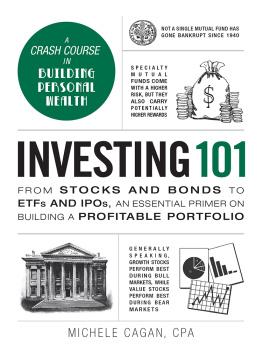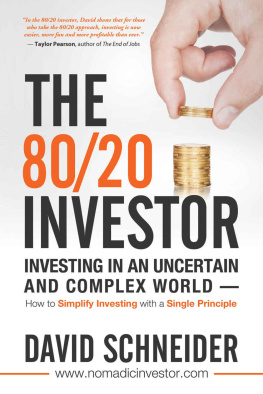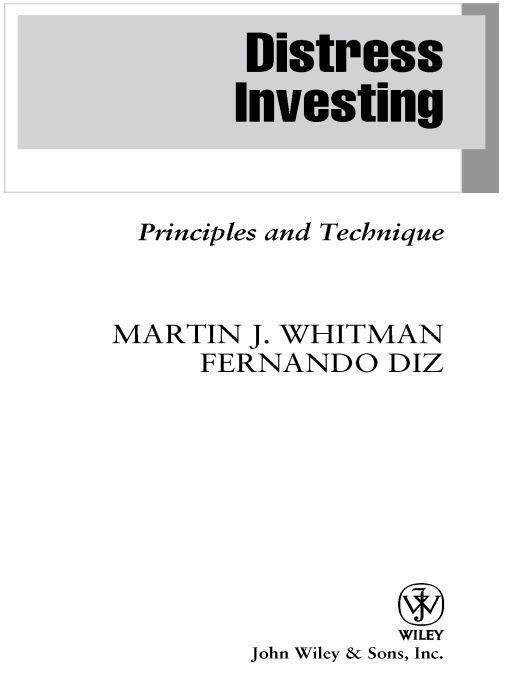Table of Contents
Additional Praise for
Distress Investing: Principles and Technique
istress Investing: Principles and Technique presents a concise, practical description of the restructuring process, the various players in the process and the constraints and incentives motivating their actions, as well as the institutional and economic forces impacting the process. The power of this holistic view is demonstrated in many actual distressed investing situations. Without the wisdom in this book anyone investing in distressed securities runs the risk of becoming a distressed investor!
STAN GARSTKA
Deputy Dean and Professor in the Practice of Management,
Yale School of Management
Marty Whitman and Fernando Diz have produced an extraordinary guide to todays world of distressed investing. Drawing on Whitmans 50+ years of successful experience in the field, they have explained in straightforward terms how an investor can construct a portfolio of distressed investments within todays complex variety of different securities. While there are no guarantees of ultimate investment performance, following these principles will enhance the probability of above average portfolio returns.
JOSEPH W. BROWN CEO, MBIA Inc.
In a world puzzled about the reasons for the collapse of our economy, we are fortunate to have two gifted observers, the authors of this book, who understand the elusive intricacies of the problem and explain their details so effectively.
WILLIAM BAUMOL
Academic Director, Berkley Center for Entrepreneurship
Studies, New York University
A very comprehensive and thorough analysis of a timely and interesting topic. Filled with exciting and sometimes provocative insights, this is a must-read for the uninitiated as well as those deeply immersed in the topic.
ANDREW DENATALE Partner, White & Case LLP
Founded in 1807, John Wiley & Sons is the oldest independent publishing company in the United States. With offices in North America, Europe, Australia, and Asia, Wiley is globally committed to developing and marketing print and electronic products and services for our customers professional and personal knowledge and understanding.
The Wiley Finance series contains books written specifically for finance and investment professionals as well as sophisticated individual investors and their financial advisors. Book topics range from portfolio management to e-commerce, risk management, financial engineering, valuation, and financial instrument analysis, as well as much more.
For a list of available titles, visit our Web site at www.WileyFinance.com.
To my wife Lois To my children and spouses and companionsJim and Sara; Barbara and Dave; Tom and Mira
To my grandchildrenDaniel, Will, Nathaniel, Lucien, Raphael, and Rosalie
Martin J. Whitman
To my parents, Alfonso and Lelia, for their unwavering support
To Pepa for her patience
To Claudia, Emmett, Mateo, and Patricia
Fernando Diz
Foreword
Today, one only needs to read the press or view the media to see how most people are struggling to understand the problems brought on by the deepest financial crisis that our country has seen in decades.
Even the very people we trust are struggling to find solutions to these problems. The current financial crisis has made it extremely important for all market participants, and the public alike, to better understand our nations reorganization and liquidation processes.
Renowned distress investor Martin J. Whitman and Professor Fernando Diz do just that in this volume. In laymans terms, they walk the reader through the various processes that companies in financial distress use to either reorganize as going concerns or to liquidate. In doing so, they map the risks, rewards, conflicts of interests, and communities of interest faced by all participants in such processes: creditors, managements, control investors, passive investors, shareholders, professionals, employees, government, and the company itself. The book includes relevant discussions about the external forces, in todays environment, imposing or not imposing discipline on market participants. These discussions should prove very helpful to policy makers trying to find solutions for the diverse constituencies involved.
During the current financial crisis, the U.S. government has become the credit enhancer of last resort and policy makers are now struggling to decide where and how such power should be used. The contents of this book should provide a roadmap for deciding where such enhancements may prove helpful and where they will not. Throughout the book the authors highlight the notion of a business as a going concern and how this notion is at odds with current mark-to-market accounting for the types of businesses that are at the heart of the current financial crisis. As politicians and government officials debate the good bank/bad bank and/or buying toxic assets ideas, it is clear that they are trapped in liquidating concepts of insolvency rather than the more realistic going concern concepts. This confusion has made it more difficult to change accounting rules that are unrealistic for many businesses and create regulatory insolvencies that have paralyzed such businesses.
Many of the ideas in the book are also quite helpful to private equity investors who will undoubtedly play an important role in the solution of this crisis.
This is a one-of-a-kind book, a must read if you truly hope to understand many of the problems that businesses face in todays financial environment.
DANIEL DNIELLO
Co-founder and Managing Director
The Carlyle Group
Preface
This book is an outgrowth of annual seminars the two of us taught together at Syracuse Universitys Martin J. Whitman School of Management for the past seven years. The subject matters of these seminars were distress investing and value investing. We hope that many of the teachings in this volume will be helpful not only to the distress investor and the value investor, but also to the control investor and other parties interested in corporate restructurings. There are many investors who deploy funds away from cashlike investments only into situations where they have, or believe they can get, elements of control over a going concern and/or the reorganization or liquidation processes for troubled companies. In 2008 and 2009 it seems obvious that an important future activity will be obtaining control of both reorganization processes and troubled companies that are being reorganized.
One area that this book hardly touches on is the trading environment for distress credits. That is not where our talents or interests lie. Rather, the book is about buy-and-hold investing in distressed credits. Most distressed credits are likely to be performing loans or reinstated issues in the event an issuer has to be reorganized. Reinstatement means that the contract rights inherent in the credit instrument are restored. Principal is paid in accordance with the terms described in the bond indenture or loan agreement, as are contracted-for premiums, if any, as well as interest and interest on interest if there are any nonpayments during the reorganization period. If the analyst managing a debt portfolio is right in postulating that a performing loan will remain a performing loan, or that in the event of reorganization the loan will be reinstated, then the analyst doesnt ever have to worry about market prices. At this writing, for example, the Forest City Enterprises









